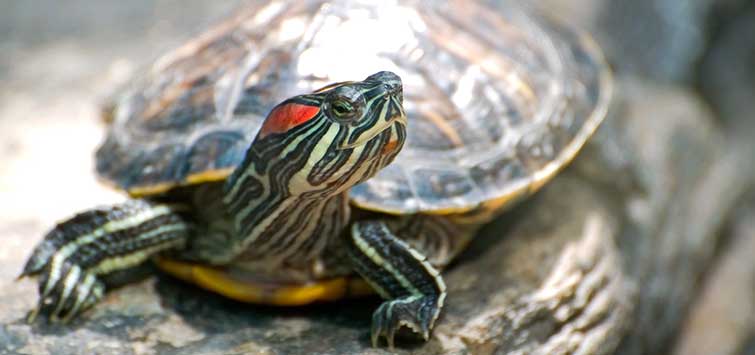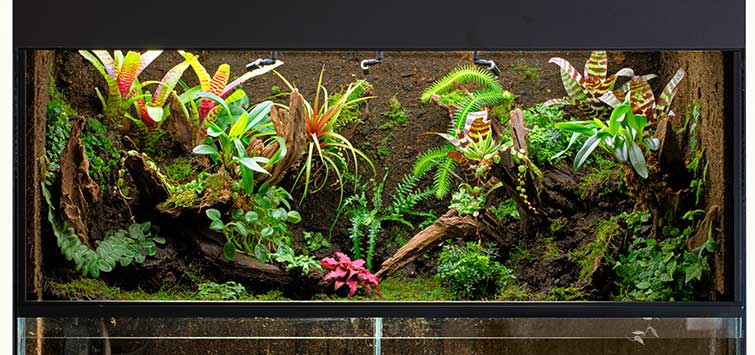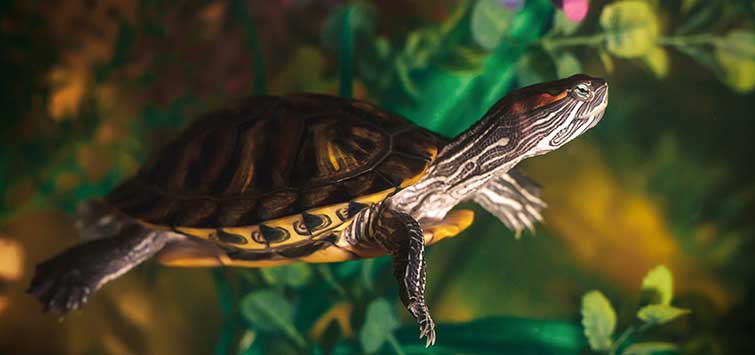The Care and Reproduction of the Red-Eared Slider
Author: Radek Bednarczuk
It takes a special aqua-terrarium setup to properly keep the popular and charismatic Trachemys scripta elegans; a dedicated turtle fan explains how.
Red-Eared Slider Habitat
The natural environment of the red-eared slider (Trachemys scripta elegans) is the southeastern part of the United States and Mexico, although some subspecies can be found near the border of Canada. Its natural habitat is the moist environment of lakes and slow-moving rivers. It can also be found in shallow pools with soft, muddy bottoms and swamps.
Aquarium Habitat
The tank for an adult pair of red-eared sliders should have a minimum capacity of about 285–340 liters (75–90 gallons), with a length of 120 cm (48 inches), a width of 45 cm (18 inches), and a height of 50–60 cm (20–24 inches).
These turtles are great swimmers, and they like to dive. Their tank should be as large as possible because the adult specimens are about 25 cm (10 inches) long. The water depth should be sufficient to allow the turtle to turn itself over should it fall on its back. Their habitat should include swimming room for the animal, and an island, such as a stable pile of large stones or a tree branch, on which it can rest and warm itself. The island should occupy about one-fourth of the tank. It should also be remembered that the turtle must be able to climb up the island easily as well as slide off if it feels threatened. The bottom of the aquarium is best covered with gravel. If you plan to breed the turtles, take care to provide a land area made of sand, where the female will bury her eggs.
The turtles feed on plant matter, so if you would like to keep live plants, a pane of glass can be inserted at the back of the tank, and the plants placed behind it. We must remember, however, that in this case, the aquarium should be wider. Artificial plants can also be used.
Lighting
As I have mentioned, red-eared sliders like to bask in the sunlight. Therefore, it is best to install a special UVB lamp for terrarium use over the artificial island. Its basking time should be 10–12 hours. In its natural environment, the turtle can often be found sunbathing, the major advantage of this activity being the synthesis of vitamin D3, which allows the animal to assimilate calcium and phosphorus. Calcium deficiency, common in turtles, is not caused by the lack of this element in their food, but by the lack of vitamin D3. Underexposure to UVB radiation, especially in young specimens, will lead to rickets.
Remember not to place glass between the UVB lamp and the island because the valuable radiation will not pass through it. The lamp should be periodically replaced with a new one, once every year to 1½ years on average, as it loses its properties over time.
The difference in the temperature of the water and the heated air should not be too great because this can make the turtles ill. It is best to cover the aquarium with a pane of glass or a special hood. Air humidity over the island should be kept at around 70 percent.
Water Temperature
The aquarium should be equipped with a heater, set to maintain the temperature at around 25–28°C (77–82°F), but the water temperature should be lower at night. You can protect the heater from accidental breakage, for instance by inserting it into a PVC pipe with numerous holes, or a heating pad can be used instead. The best solution, however, is to purchase a canister filter that has an integrated heater.
Filtration
Because of the high metabolic rate of these turtles, the aquarium should have excellent, efficient filtration—a sump or a combination of an undergravel filter and a large canister filter would be best. The water should be changed every week, in the amount of 20–30 percent. It’s also important to wash your hands well after maintenance chores, and to avoid sucking the water from the hose with your mouth, because there is a significant risk of infection with salmonella, which is often carried by these turtles.
Cleaning
As they grow, turtles shed the scutes of their carapaces, and those should be removed from the tank for aesthetic reasons. Sometimes the carapace of the turtle turns green with algae. To eliminate this, the animal should be caught from time to time to have its shell cleaned, with a sponge for instance. While cleaning, however, be sure to steer clear of the razor-sharp jaws of the turtle, as well as its claws. In summertime, it is best to keep the animals in a pond or pool with an island at the center, preferably without fish, which are the turtle’s natural food.
Feeding
Young red-eared sliders are more carnivorous than older ones. With the passage of time, the ratio shifts towards plant-based foods, which should then make up two-thirds of the menu that we give to these animals. The basis of their diet should be live fish, snails (e.g., large apple snails), the larvae of water animals, crustaceans (shrimp), as well as all kinds of aquatic plants (e.g., arrowhead, water lily, water hyacinth, and duckweed).
Many people give their turtles lettuce. Unfortunately, this is not recommended, as it contains oxalates, which effectively bind up calcium, so the animals can suffer from hypocalcaemia, which weakens their shells and their kidneys.
They should not be given the meat of mammals and birds, or fruits and vegetables, either. The meat of mammals is not a good food for turtles; it is not part of their natural diet, and they are not adapted to digesting it. To vary their diet, we can feed them earthworms and small insects. The turtles should also be given calcium and vitamins A and D3 to make up for any lack in the food (in their natural environment, they get calcium from fish bones).
Young turtles should be fed daily, while older ones should be fed twice a week on average. Ready-made turtle food should constitute only a small percentage of their menu.
Reproduction
In this species, the sexes can be told apart at 2–3 years of age. The males have distinctively long claws. The male and the female also differ in their tails: The female’s tail is short and narrow with the cloaca positioned at its base, while the male’s tail is long and widened with the cloacal opening situated farther from the body, beyond the middle of the tail. The males are also smaller than the females, and their plastron (bottom shell) is flatter. The females become sexually mature at 5 years of age, while the males usually do so 3 years earlier.
Hibernation
If you have a pair of turtles and intend to breed them, you should give them an opportunity to hibernate for the winter. However, in artificial conditions, this procedure poses some risks to the health, and even life, of the animal. Before the planned "wintering," stop feeding and then gradually lower the temperature to 3–5°C (37–41°F). The turtles should then be kept at this temperature, in a water-filled container, for about four months, while constantly monitoring the health of your charges, the temperature, and the water quality.
The best method, which gives almost 100 percent certainty of achieving reproduction, is uniting the pair after that period of winter rest. In their natural environment, turtles breed in the spring, in March and April. The males perform mating dances in the water, fluttering their paws overhead to impress their partner. Then copulation takes place, also in the water. About a month after mating, the female lays from 2 to 24 eggs.
Eggs
In the aquarium, the female requires a dry land area, with a patch of slightly moist sand, 25 cm (10 inches) in depth, in which she will lay her eggs. It is best to divide the tank with a pane of glass placed crosswise and glued in place with silicon to create distinct water and land areas. The latter—occupying one-third of the tank—should be filled with a mixture of peat and sand. A few stones or pieces of wood can be added for decoration. Air humidity should be 90 percent, which helps to ensure proper development of the eggs. Under no circumstances should the eggs be turned over. Some of them might be unfertilized, but those that do contain young will increase in size.
In the area where the developing eggs reside, there should be good ventilation to prevent the eggs from being destroyed by fungus. If this happens, they turn gray-green, and such eggs need to be removed immediately. Professional breeders use special incubators for the developing eggs.
Hatching
The young hatch in 70–100 days, depending on the incubation temperature (26–32°C [79–89.5°F]). Immediately after hatching, they are around 28–32 mm long, about 30 mm wide, and 4–6 grams in weight. They should be transferred to a separate terrarium that is filled with water, contains a large island with a heat lamp, and is properly equipped with a heater, filter etc.
When the yolk sac is absorbed, give them finely chopped fish, shrimp, artemia, and bloodworms, all while supplementing their diet with vitamin D3 and calcium. Deficiency of these two nutrients will lead to eye disease, which manifests as swollen lids, difficulty in opening the eyes, and respiratory sickness.
As a point of interest, Trachemys scripta elegans is the object of intensive biological research into the mechanism of sex-ratio regulation in its young, which depends on the temperature at which the eggs develop. Reproduction of this species of turtle can be laborious and difficult, so one should think twice—and then some—before deciding to breed it.
Pets, Not Toys
Young turtles are small, green, active, and very charming animals. However, as they age, they will get bigger, eat more, and produce more waste, as well as become darker and less attractive. When young, they are often bought as "toys" for children, but as they grow, they require a larger tank and better maintenance. For this reason, the purchase of a turtle should be a well-thought-out decision, as this species can reach an advanced age of 30 years in its natural environment and more than 35 years, or even longer according to some hobbyists, in captivity.
As the most popular species in captivity, the red-eared slider has found its way into similar biotopes in other parts of the world, including Europe, Asia, and the Americas, mostly as a result of being released into the wild.
The red-eared slider has a diurnal lifestyle and can often be found basking in the sun, either on the banks or the stones and roots that jut out of the water. It is an excellent swimmer and diver, and when faced with a threat, it immediately escapes by sliding into the water—hence the second part of its common name. The animal never moves far away from water, but in unfavorable conditions, an adult turtle can survive up to a few days on dry land.
Its carapace (top shell) is oval and flattened, with a weak keel, and is olive-green to almost black in some older males. In young specimens, the carapace and skin are yellowish-green to dark green. On the sides of its green head are red stripes that widen toward the back—hence the first part of its common name. Below the red "ears" are bright yellow stripes. The toes are webbed.
See the full article on TFH Digital http://www.tfhdigital.com/tfh/april_2014#pg61

.png?h=595&iar=0&w=2781&hash=5FD5E69473BCC22199FBFA2FB71B6033)









